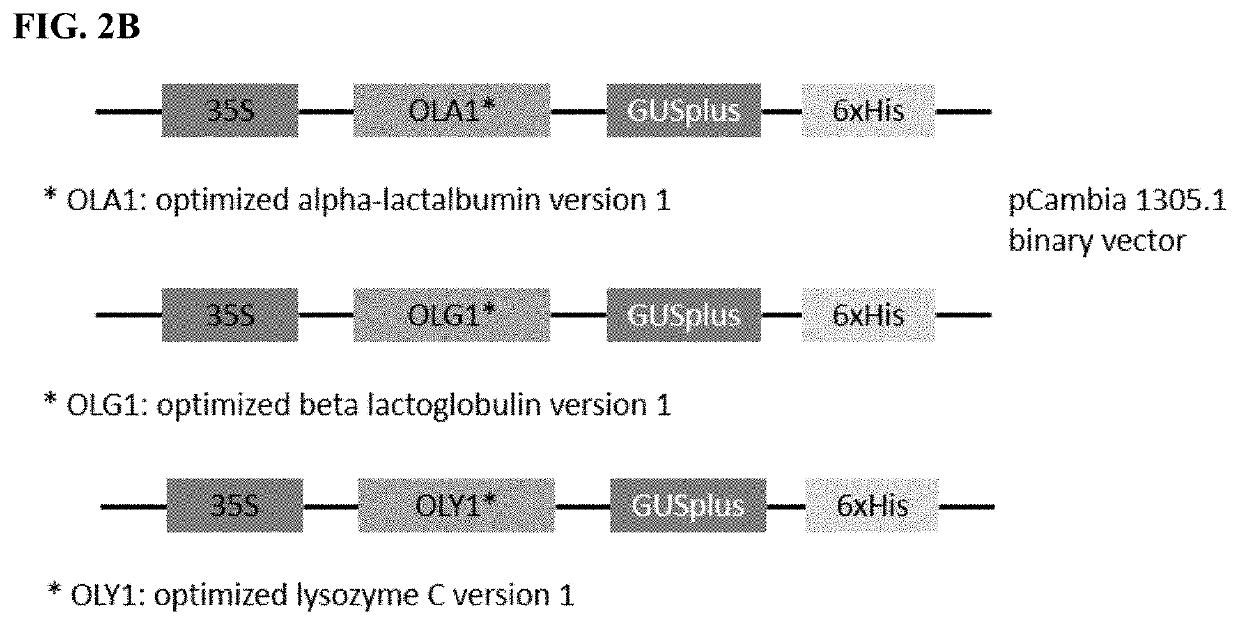Milk protein production in transgenic plants
a technology of transgenic plants and milk proteins, applied in the field of milk protein production, extraction, purification, etc., can solve the problems of animal agriculture posing a serious risk to human health and not being able to meet the growing demand for food
- Summary
- Abstract
- Description
- Claims
- Application Information
AI Technical Summary
Problems solved by technology
Method used
Image
Examples
example 1
ion of Expression Vectors for Plant Transformation for Transient and Stable Expression of Recombinant Milk Proteins
[0342]The soybean codon-optimized nucleic acid sequences coding for milk proteins were synthesized and cloned into a binary vector pCambia1305.1, respectively. The codon-optimized DNA sequences are listed in Table 2 as follows; i) OKC1 (Optimized Kappa Casein version 1) ii) OKC1-T (Optimized Kappa Casein Truncated version 1), iii) OBC1 (Optimized Beta Casein version 1), iv) OBC1-T (Optimized Beta Casein Truncated version 1), v) OS1C1 (Optimized alpha S1 Casein version 1), vi) OS2C1 (Optimized alpha S2 Casein version 1), vii) OLA1 (Optimized Alpha Lactalbumin version 1), viii) OLG1 (Optimized Beta Lactoglobulin 1), and ix) OLY1 (Optimized Lysozyme C version 1).
[0343]Each of the codon-optimized nucleic acid sequences encoding milk proteins was inserted between a CaMV 35S promoter and GUSPlus™ gene in a binary vector pCambia1305.1. For the insert ligation, two restriction ...
example 2
Expression of Milk Proteins (Casein and Whey) in Tobacco and Soybean
[0350]Sequence information of four types of casein protein (α-S1, α-S2, β, κ) were collected from NCBI (GenBank accession No. ACG63494.1 (SEQ ID NO:15), NP_776953.1 (SEQ ID NO:16), AGT56763.1 (SEQ ID NO:17), AAQ87923.1 (SEQ ID NO:18)), as well as three types of whey protein (α-lactalbumin, β-lactoglobulin, lysozyme) were collected from NCBI (GenBank accession No NP_776803.1 (SEQ ID NO:25), NP_776354.2 (SEQ ID NO:26), NP_001071297.1 (SEQ ID NO:27)), representing sequence information of seven bovine milk proteins. Then, the sequences obtained from GenBank were optimized based on soybean codon usage frequency (idtdna.com / CodonOpt). See, for examples, Plotkin et al., Nat. Rev. Genet. 12:32-42, 2011; Sharp, Nucl. Acids. Res. 15:1281-1295, 2009; and Cannarozzi et al., Cell 141:355-367, 2010. Each synthesized fragment from the soybean codon-optimized DNA sequences encoding milk proteins was ligated into pCambia1305.1 binar...
example 3
tection of Transient Expression of Milk Proteins (Casein and Whey) in Tobacco and Soybean
[0356]Since GUSPlus™ was fused with codon-optimized transgenes of interest in each construct, histochemical staining of beta-Glucuronidase (GUS) was used to evaluate transient expression in the tobacco leaves, and also the soybean seedlings. 3 days after the agro-infiltration, leaves were taken off from the seedlings and submerged in the staining buffer provided by beta-Glucuronidase (GUS) reporter gene staining kit (sigma, www.sigmaaldrich.com / united-states.html). After 24 hours of staining and 6 hours distaining, the leaves were scanned and blue areas would be calculated by publicly-available ImageJ program.
[0357]Infiltration experiments using Agrobacterium carrying recombinant expression vectors illustrated in FIGS. 2A and 2B showed successful transient expressions of milk proteins including κ-casein protein (OKC1), truncated κ-casein protein without signal peptide (OKC1-T), β-casein protein ...
PUM
 Login to View More
Login to View More Abstract
Description
Claims
Application Information
 Login to View More
Login to View More - R&D
- Intellectual Property
- Life Sciences
- Materials
- Tech Scout
- Unparalleled Data Quality
- Higher Quality Content
- 60% Fewer Hallucinations
Browse by: Latest US Patents, China's latest patents, Technical Efficacy Thesaurus, Application Domain, Technology Topic, Popular Technical Reports.
© 2025 PatSnap. All rights reserved.Legal|Privacy policy|Modern Slavery Act Transparency Statement|Sitemap|About US| Contact US: help@patsnap.com



